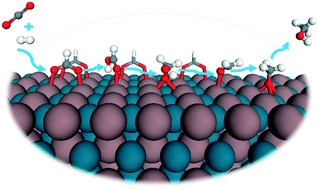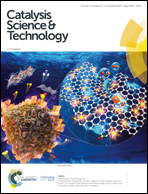Intermetallic PdIn catalyst for CO2 hydrogenation to methanol: mechanistic studies with a combined DFT and microkinetic modeling method†
Abstract
Great efforts have been made to explore efficient catalysts for methanol synthesis from CO2 hydrogenation. Recently, it was found experimentally that the PdIn intermetallic catalyst showed high activity, selectivity and stability for this reaction. In order to understand the underlying reaction mechanisms over the PdIn intermetallic catalyst at the atomic level, we here investigate the reaction pathways of methanol and carbon monoxide formation over PdIn(110) and PdIn(211) with a combined density functional theory and microkinetic modeling approach. We find that CH3OH formation is mainly via HCOO → HCOOH → H2COOH → CH2O + OH → CH3O + OH → CH3OH(g) + H2O(g) on both surfaces. The direct dissociation of CO2 to CO and O is favored on PdIn(110) for CO formation, whereas the preferred CO formation pathway on PdIn(211) is through the formation of COOH and its subsequent dissociation to give CO and OH on the surface. The microkinetic modeling results also show that, at steady state, the coverage of HCOO on both surfaces is rather high and may not be ignored. Degree of rate control (DRC) analysis results suggest that the transition state of O and CO2 hydrogenation over PdIn(110) and PdIn(211), respectively, can be considered rate controlling for CO formation. Regarding the formation of methanol, the DRC analysis results show that the transition state of HCOOH hydrogenation to H2COOH is the rate-controlling transition state on PdIn(110) over the whole temperature range studied. In contrast, the rate-controlling transition state varies from H2COOH dissociation to HCOOH hydrogenation with increase in temperature for PdIn(211). In addition, we propose an approach to estimate the formation rates of methanol at different formate coverages on the basis of the effective rate-controlling step identified from the DRC analysis. It was found that the activity of methanol formation on both surfaces studied is enhanced at high formate coverage under practical reaction conditions.



 Please wait while we load your content...
Please wait while we load your content...